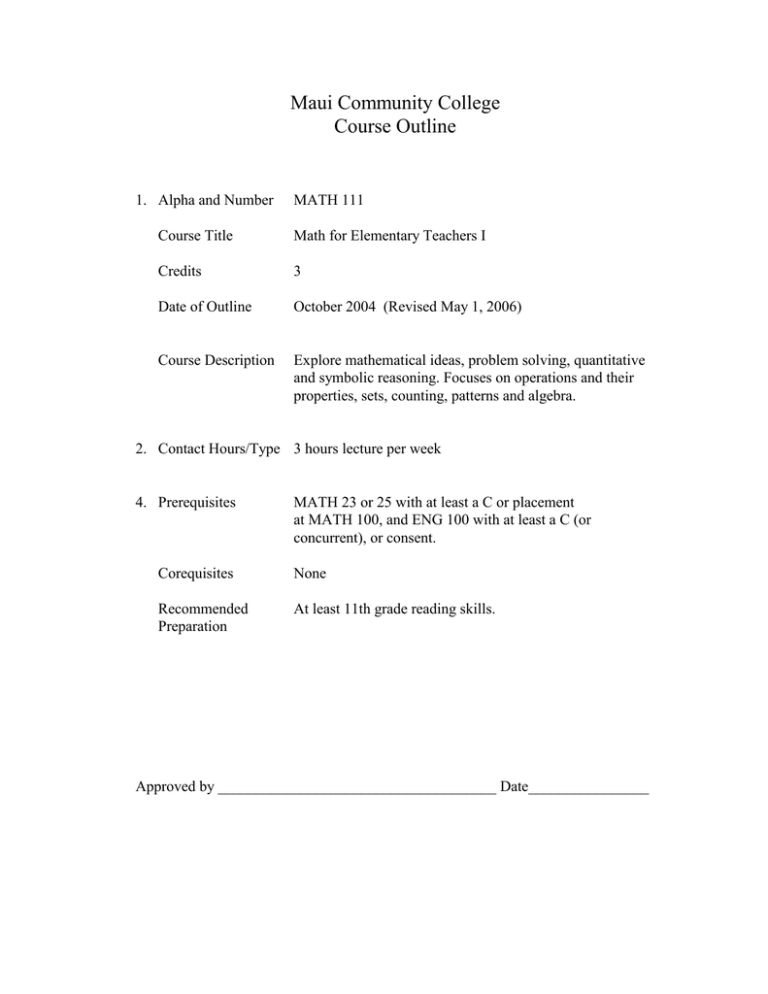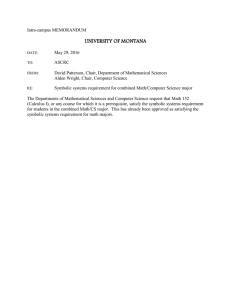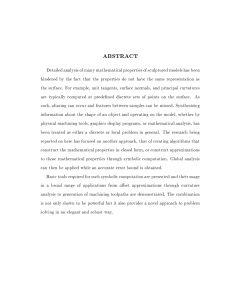Maui Community College Course Outline
advertisement

Maui Community College Course Outline 1. Alpha and Number MATH 111 Course Title Math for Elementary Teachers I Credits 3 Date of Outline October 2004 (Revised May 1, 2006) Course Description Explore mathematical ideas, problem solving, quantitative and symbolic reasoning. Focuses on operations and their properties, sets, counting, patterns and algebra. 2. Contact Hours/Type 3 hours lecture per week 4. Prerequisites MATH 23 or 25 with at least a C or placement at MATH 100, and ENG 100 with at least a C (or concurrent), or consent. Corequisites None Recommended Preparation At least 11th grade reading skills. Approved by _____________________________________ Date________________ 2 5. General Course Objectives Maui Community College Standards: Outcome 2.1 - Apply numeric, graphic, and symbolic skills and other forms of quantitative reasoning accurately and appropriately. Outcome 2.2 - Demonstrate mastery of mathematical concepts, skills, and applications, using technology when appropriate. Outcome 2.3 - Communicate clearly and concisely the methods and results of quantitative problem solving. Outcome 2.4 - Formulate and test hypotheses using numerical experimentation. Outcome 2.5 - Define quantitative issues and problems, gather relevant information, analyze that information, and present results. Outcome 5.1 – Identify and state problems, issues, arguments and questions contained in a body of information. Outcome 5.2 – Identify and analyze assumptions and underlying points of view relating to an issue or problem. By System agreement, this course is not designed to satisfy the following Foundations Symbolic Reasoning criteria for the University of Manoa while MATH 112 is designed to satisfy that requirement. This course is appropriate to be offered as writing intensive. 6. Specific Course Objectives, Competencies, and Student Learning Outcomes For assessment purposes, these are linked to #7. Recommended Course Content. On successful completion of this course, students will be able to a. communicate mathematical thinking coherently, clearly and precisely and understand mathematics when they read it; b. communicate and read presentations using both words and the symbolic language of mathematics; c. describe objects, sets, patterns and processes both in words and symbols by developing mathematical representations; d. apply and adapt a variety of appropriate strategies to solve problems; e. build new mathematical knowledge through problem solving; f. explore concepts, patterns and relationships; g. explain ideas in more than one way; h. recognize and use connections among mathematical ideas; i. recognize problems in different contexts to understand new ideas and solve problems; j. hypothesize and investigate mathematical conjectures; k. generalize discoveries; 3 l. construct and evaluate mathematical arguments and proofs. 7. Recommended Course Content and Approximate Time Spent on Each Topic Linked to #6. Specific Course Objectives, Competencies, and Student Learning Outcomes. 2 weeks Introduction to the course syllabus including a discussion of what will be expected throughout the semester Operations and their Properties Introduction Commutativity Associativity Identities Inverses Multiplication on the natural numbers Distributive properties (a,b,c,d,e,f,g,h) 3-4 weeks Lists Introduction Joining Lists Other Operations on Lists Amalgams of Lists (a,b,c,d,e,f,g,h,i,l) 3-4 weeks Sets Definitions The operation of “Union” on sets Other operations of sets Describing sets (a,b,c,d,e,f,g,h,i,l) 3-4 weeks Counting Pairing Inclusion-Exclusion Identities The Fundamental Counting Principle Cartesian product of sets Counting in a Cartesian Product Counting Color Patterns Counting Subsets Likelihood (a,b,c,d,e,f,g,h,i,j,k,l) 4 3-4 weeks Data Factories Addition and Composition Diagrammatic and Symbolic Representations Comparing Data Factories Employees or Offices at Work (a,b,c,d,e,f,g,h,i,j,k,l) 8. Text and Materials, Reference Materials, Auxiliary Materials and Content Appropriate text(s) and materials will be chosen at the time the course is offered. By University of Hawaii Systemwide agreement on September 18, 2004, campuses agreed to use materials created by Joel Weiner with support of Neil Pateman, Instructor for ITE 324, 325 (Elementary Mathematics I, II) College of Education. MCC supports this agreement to facilitate systemwide articulation of MATH 111. Additional materials such as Thomas Sonnabend Mathematics for Teachers will be used for reference materials. 9. Recommended Course Requirements and Evaluation Specific course requirements are at the discretion of the instructor at the time the course is being offered. 55%-90% Written – in-class exams 5%- 25% 0%-30% 10%-25% Out-of-class work (including take home exams and homework) In-class exercises and group work Written reflective papers 10. Methods of Instruction Instructional methods will vary considerably with instructors. Specific methods will be at the discretion of the instructor teaching the course and the method by which the course is taught. These might include but are not limited to a. b. c. d. e. f. g. h. i. exams and papers with feedback and discussion lectures (kept to a minimum) and class discussion problem solving Power Point presentations (kept to a minimum) videos, DVDs, CD-ROMs with detailed viewing guide and discussion questions group activities oral reports and other student presentations games and simulations web-based assignments and activities 5 j. k. l. m. reflective journals or papers group and/or individual research projects with reports or poster presentations study logs and study groups other contemporary learning techniques (such as problem-based learning, investigative case-based learning) n. homework assignments




